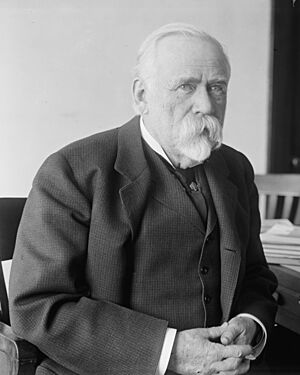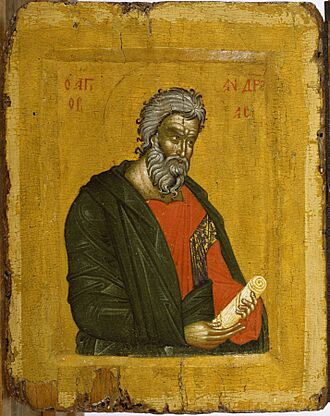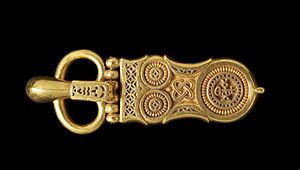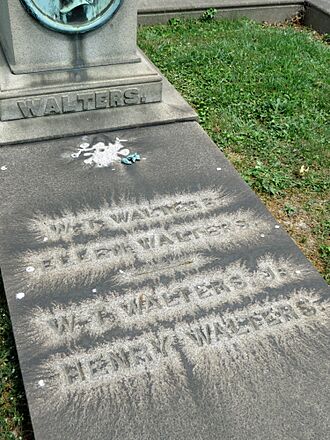Henry Walters facts for kids
Quick facts for kids
Henry Walters
|
|
|---|---|
 |
|
| Born | September 26, 1848 |
| Died | November 30, 1931 (aged 83) New York City, U.S.
|
| Resting place | Green Mount Cemetery, Baltimore |
| Nationality | American |
| Known for | Art Collector |
| Parent(s) | William Thompson Walters (1820–1894) Ellen (Harper) Walters |
Henry Walters (born September 26, 1848 – died November 30, 1931) was a famous art collector and a generous giver to charity. He helped start the Walters Art Museum in Baltimore, Maryland. He gave this amazing art collection to the city in his will in 1931, so everyone could enjoy it.
For much of his life, Henry Walters lived in New York City. From 1903, he was part of the main committee at the Metropolitan Museum of Art in Manhattan. He became the second vice president there in 1913 and held that job until he passed away.
Just like his father, William Thompson Walters, Henry was also a successful businessman in the railroad industry. He was the president of the Atlantic Coast Line Railroad from 1894 to 1902, a company his father had started.
Contents
Early Life and Education
Henry Walters was born in 1848. His father, William Thompson Walters, was a businessman who later created the Atlantic Coast Line Railroad. Henry went to Georgetown University in Washington, D.C., and graduated in 1869. He then continued his studies at the Lawrence Scientific School at Harvard University from 1869 to 1872.
Building a Railroad Empire

In 1889, Henry Walters moved to Wilmington, North Carolina. There, he became the general manager of his father's company, the Atlantic Coast Line Railroad. When his father died in 1894, Henry was chosen to be the company's president. He then moved the railroad's main office from North Carolina to New York City.
Under Henry's leadership, the railroad grew very quickly, especially before World War I. In 1902, he also took control of another major railroad, the Louisville and Nashville Railroad.
Life in New York City
In New York City, Henry Walters lived with Pembroke and Sarah Jones, who were good friends he had met in Wilmington, North Carolina. All three of them loved art, and their home was filled with their many collections. Henry didn't often go back to Baltimore, except for important business meetings.
After Pembroke Jones died in 1919, Henry Walters married Sarah Jones in 1922. They continued to live in their Manhattan home, surrounded by their impressive art collections. Henry Walters passed away in 1931.
Henry Walters as an Art Collector
When Henry's father died in 1894, he left his art collection to Henry. Henry then greatly expanded this collection. He even bought all the art from a palace in Rome, which included over 1,700 pieces!
In September 1900, Henry bought three houses next to his father's property in the Mount Vernon area of Baltimore. He wanted more space to show off the entire collection. He had the buildings designed to look like an Italian palace. This new building opened to the public in 1909 as the Walters Art Gallery.
Henry Walters also gave four public bath houses to the City of Baltimore. One of these, Walters Bath No. 2, is now a historic landmark.
Henry wanted the museum to help educate the community. At first, he made small additions to his father's collection. For example, in 1897, he bought a 15th-century Koran, which is a holy book.
In 1900, Walters bought Madonna of the Candelabra by the famous artist Raphael. This painting had once belonged to important families like the Borghese and Bonaparte families. The U.S. Postal Service even put this painting on its Christmas stamp in 2011!
Major Art Purchases
In 1902, Henry Walters made a huge art purchase, unlike anything seen before in America. He bought all the art from the Palazzo Accoramboni in Rome. This collection had many important artworks. Some were found to be by different artists than first thought, and others were by artists who weren't popular at the time. An example is St. Francis Receiving the Stigmata by El Greco.
The collection also included amazing ancient treasures, like seven large stone coffins from a burial place linked to the Calpurnii Pisones family. Walters agreed to buy the entire collection for five million Italian lire, which was about $1.0 million back then.
He also added more art from the 1800s, like The Betrothal of Raphael and the Niece of Cardinal Bibbiena by Ingres, which he bought in 1903. Even though Walters wasn't a big fan of French Impressionist art, he bought two works in 1903 from American artist Mary Cassatt, including Springtime by Claude Monet.
Walters kept adding to his collections, buying art both in New York and from other countries. He collected art from ancient Egypt, the ancient Near East, and Islamic cultures. He also bought many important classical and western medieval objects. These included two limestone heads of Old Testament rulers from the abbey church of Saint-Denis.
From 1903, Walters was on the executive committee of the Metropolitan Museum of Art. In 1913, he became the second vice president, a role he kept for the rest of his life. His experiences on different museum committees might have changed how he collected art after World War I. He started focusing more on artworks that were very important historically and artistically.
Death and Legacy
Henry Walters died in 1931. In his will, he left the museum building and all its art to the mayor and city council of Baltimore. He did this "for the benefit of the public," meaning for everyone to enjoy. The Walters Art Museum officially opened its doors as a public museum on November 3, 1934.



